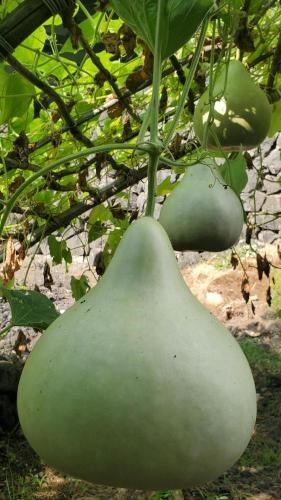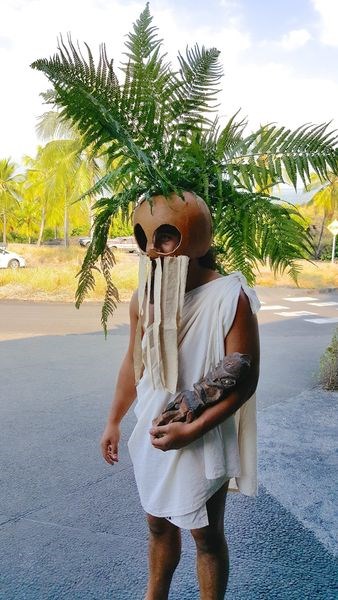Last updated: May 5, 2021
Article
Polynesian Heritage Plants: Ipu

NPS / Chisholm
Ipu (ĭ'-pŭ)
Bottle Gourd
Lagenaria siceraria
Cucurbitaceae Family
Polynesian Introduced
ʻAʻohe ipu ʻōpio e ʻole ka mimino i ka lā.
No immature gourd can withstand withering in the sun [without care].
[No child can get along without adult supervision]
Description
A climbing vine with large (4-16 in.) five-lobed leaves. Ipu are often grown on a trellis as pictured to the right. During the flowering stage, small, single white flowers are produced. If pollinated, a soft, hairy, green ipu fruit begins to grow. These hairs provide protection from insects and other pests. Ipu takes about 6-9 months to fully mature, becoming smooth as they mature. Gourds can be all shapes and sizes. When mature, the vine is cut, the inner flesh removed, and the gourd is dried turning from green to a golden brown.
Traditional Uses

NPS Photos
Native to tropical Africa and Asia, ipu came to Hawaiʻi aboard the ancestors’ canoes. In ancient Hawaiʻi, with no pottery, kānaka maoli (native Hawaiians) relied heavily on dried, hardened ipu for containers. Slender long-necked ipu wai (water) to store liquids--like your modern waterbottle--and ipu ʻumeke (bowl) with a shorter neck and wider base to use as bowls or dry containers.
Use of ipu extends beyond the practical container to the arts. The hollowed, thin-skinned ipu produce a beautiful sound and thus were made into a variety of musical instruments. Many of these instruments are used in hula like ʻuli ʻuli (hula rattles) and ipu heke (percussion instrument made by joining two ipu on top of each other). An intricate form of decoration, unique to Hawaiʻi, was also developed to adorn ipu. This art, once almost lost to time, saw a resurgence in the 1970s. Today, artists and cultural practitioners continue this traditional practice of scratching a design then dying the ipu from the inside out, the Niʻihau method.

Hawaiʻi Pacific Parks Association
Cultural Significance
In Native Hawaiian culture, ipu holds a special significance as it embodies the akua (god) Lono and is considered a kino lau (body form) of Lono. The gourd also represents the earth, with the seeds of all beings contained within.
Ipu appear in many moʻolelo (stories) such as this moʻolelo from the Kāʻu district.
They are also used in rituals and ceremonies. The gourd helmet (referred to as mākini) is to this day mysterious. James Webber, an artist commissioned by Capt Cook, documented the mākini worn by men in a procession to Hikiau heiau in Kealakekua, while aboard the HMS Resolution in 1778. Their other regalia suggested they were kahuna (the priestly caste); they wore malo and kihei of bleached kapa and where observed carrying akua hulumanu (feather gods).
Ipu at Puʻuhonua o Hōnaunau
Ipu are cultivated at Puʻuhonua o Hōnaunau National Historical Park by our one of our talented volunteers using traditional practices. Cultivation of ipu requires significant attention from training vines to climb the slanted trellis to flower pollination and tending to the fruit. Once the ipu are mature they are used by cultural practitioners for a wide variety of traditional uses; from practicing traditional decoration techniques to creating vessels to be used in ceremony.
